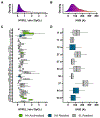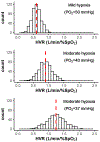The normal distribution of the hypoxic ventilatory response and methodological impacts: a meta-analysis and computational investigation
- PMID: 37589511
- PMCID: PMC10543592
- DOI: 10.1113/JP284767
The normal distribution of the hypoxic ventilatory response and methodological impacts: a meta-analysis and computational investigation
Abstract
The hypoxic ventilatory response (HVR) is the increase in breathing in response to reduced arterial oxygen pressure. Over several decades, studies have revealed substantial population-level differences in the magnitude of the HVR as well as significant inter-individual variation. In particular, low HVRs occur frequently in Andean high-altitude native populations. However, our group conducted hundreds of HVR measures over several years and commonly observed low responses in sea-level populations as well. As a result, we aimed to determine the normal HVR distribution, whether low responses were common, and to what extent variation in study protocols influence these findings. We conducted a comprehensive search of the literature and examined the distributions of HVR values across 78 studies that utilized step-down/steady-state or progressive hypoxia methods in untreated, healthy human subjects. Several studies included multiple datasets across different populations or experimental conditions. In the final analysis, 72 datasets reported mean HVR values and 60 datasets provided raw HVR datasets. Of the 60 datasets reporting raw HVR values, 35 (58.3%) were at least moderately positively skewed (skew > 0.5), and 21 (35%) were significantly positively skewed (skew > 1), indicating that lower HVR values are common. The skewness of HVR distributions does not appear to be an artifact of methodology or the unit with which the HVR is reported. Further analysis demonstrated that the use of step-down hypoxia versus progressive hypoxia methods did not have a significant impact on average HVR values, but that isocapnic protocols produced higher HVRs than poikilocapnic protocols. This work provides a reference for expected HVR values and illustrates substantial inter-individual variation in this key reflex. Finally, the prevalence of low HVRs in the general population provides insight into our understanding of blunted HVRs in high-altitude adapted groups. KEY POINTS: The hypoxic ventilatory response (HVR) plays a crucial role in determining an individual's predisposition to hypoxia-related pathologies. There is notable variability in HVR sensitivity across individuals as well as significant population-level differences. We report that the normal distribution of the HVR is positively skewed, with a significant prevalence of low HVR values amongst the general healthy population. We also find no significant impact of the experimental protocol used to induce hypoxia, although HVR is greater with isocapnic versus poikilocapnic methods. These results provide insight into the normal distribution of the HVR, which could be useful in clinical decisions of diseases related to hypoxaemia. Additionally, the low HVR values found within the general population provide insight into the genetic adaptations found in populations residing in high altitudes.
Keywords: HVR; hypoxia; hypoxic ventilatory response; population variation; variation; ventilation.
© 2023 The Authors. The Journal of Physiology published by John Wiley & Sons Ltd on behalf of The Physiological Society.
Conflict of interest statement
DISCLOSURES
The authors declare that the research was conducted in the absence of any commercial or financial relationships that could be construed as a potential conflict of interest.
Figures











References
-
- Ainslie PN, Lucas SJE & Burgess KR (2013). Breathing and sleep at high altitude. Respir Physiol Neurobiol 188, 233–256. - PubMed
-
- Aitken ML, Franklin JL, Pierson DJ & Schoene RB (1986). Influence of body size and gender on control of ventilation. J Appl Physiol 60, 1894–1899. - PubMed
-
- Albert TJ & Swenson ER (2014). Peripheral Chemoreceptor Responsiveness and Hypoxic Pulmonary Vasoconstriction in Humans. High Alt Med Biol 15, 15–20. - PubMed
-
- Amin HM, Sopchak AM, Foss JF, Esposito BF, Roizen MF & Camporesi EM (1994). Efficacy of Methylnaltrexone Versus Naloxone for Reversal of Morphine-Induced Depression of Hypoxic Ventilatory Response. Anesth Analg. 78, 701–5. - PubMed
Publication types
MeSH terms
Substances
Grants and funding
LinkOut - more resources
Full Text Sources
Research Materials

